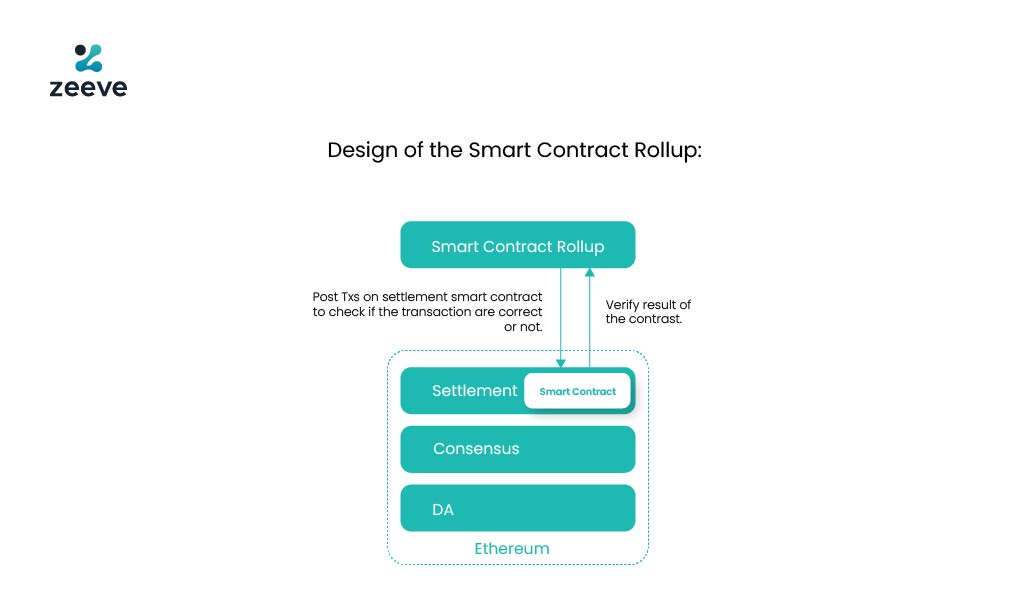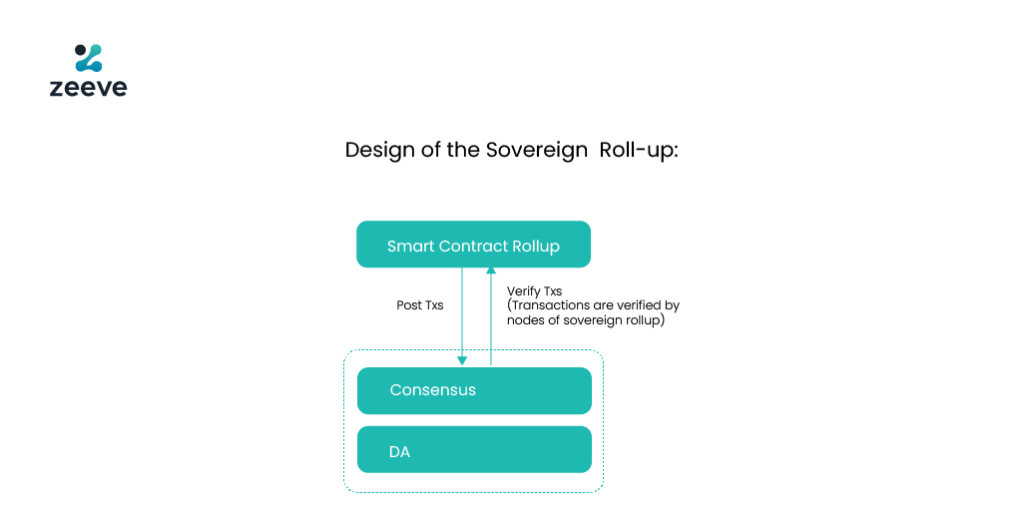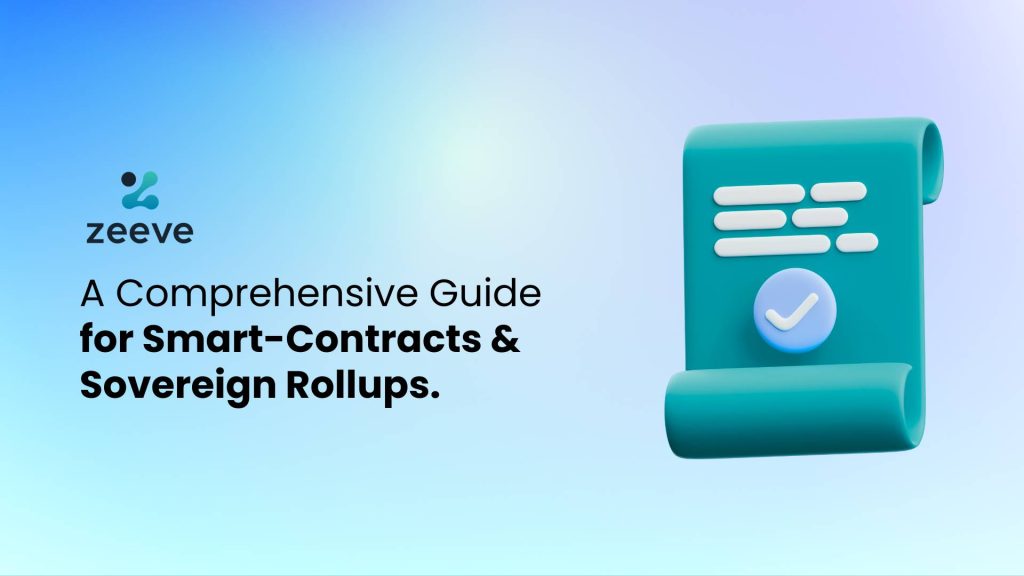The year 2024 will belong to rollups because they supercharged the possibilities of placing L1s as a go-to solution for launching a host of use cases and dapps. Nonetheless, their classes and specifications still sound Hebrew for most folks, and it wouldn’t be an understatement to conclude that greater clarity would help promulgate their adoption.
In this piece, we are trying to help the community roll with rollups by delayering smart contracts and sovereign rollups part by part so that you can understand these new rollups solutions making headlines lately. So, if you are not aware of everything that you need to know about smart contracts and sovereign roll-ups, you just found the treasure trove of information to keep you ahead. On that note, let’s begin with.
What is a Smart Contract Roll-up?
Smart Contract rollups are the kind of rollups where the execution of transactions is only handled on the rollup chain, and the rest of the operations, like consensus & DA and settlement, still happen on the Ethereum layer.
After executing the transaction on the rollup chain, they send the batched transaction data to Ethereum. Hence, we are saying they use the Ethereum layer for data availability. Again, the validity proofs/fraud proofs are sent to a settlement contract on the Ethereum layer. We call it Smart Contract rollup because your settlement is happening in Ethereum.
So, basically, they can inherit the security and decentralization of Ethereum while scaling their applications using rollup chains.
All the rollups we are building with OP Stack, Arbitrum Orbit, and Polygon CDK – are smart contract rollups.
The point to note here is it’s not mandatory for a developer to use Ethereum as a DA layer if they are building smart contract rollups. For example, you can use Polygon CDK to build your zkRollup (smart contract rollup) and settle on Ethereum, but use Celestia, maybe, as your DA layer.
Design of the Smart Contract Rollup
In a traditional smart-contract roll-up, sequencing the transaction happens on the rollups, while the L1s settle the transactions and put them into the block using the validity and fraud proofs triggered by the smart-contract RPC function, as depicted in the image, which is given below.

As you can see in the image, the roll-up submits the transactions on the L1 through a two-way trust minimized bridge, and the smart contract of the L1 would verify the change of the state of the blockchain through Merkle-Root Hash Verification function by acting as a bridge securing the rollup ecosystem. Transactions are only included in the block if L1 smart contracts receive validity and fraud proofs against them to be included in the settlement layer. However, if the smart contracts of L1 chains couldn’t verify the fraud and validity proofs, such transactions would be outwardly rejected.
When Are Smart-Contract Roll-ups Needed?
i) If your project prioritizes the established security and decentralization of Ethereum, Smart Contract Rollups are ideal. They inherit Ethereum’s robust security model.
ii) For projects that require efficient transaction processing without the high costs associated with Ethereum’s main chain, Smart Contract Rollups offer a balance between efficiency and security.
iii) If your project benefits from close integration with the Ethereum ecosystem (e.g., interoperability with existing Ethereum dApps or assets), using a Smart Contract Rollup is advantageous.
iv) Developers familiar with Ethereum’s environment will find Smart Contract Rollups more accessible, as they can continue using familiar tools and languages.
v) When you want to avoid the complexity of managing a fully independent blockchain infrastructure with multiple layers of integration, Smart Contract Rollups offer a simpler solution that still provides scalability.
What is a Sovereign Rollup?
Assume Sovereign rollups are completely modular blockchains where you need not depend on Ethereum. Be it DA, settlement, or execution, you can choose your completely modular stack. We are calling them rollups because of the technology. They execute the transactions on their own chain and then post on other blockchains for data availability. The DA layer you can choose. It could be Celestia, Near DA, or Avail, maybe. They can use some 3rd party providers to bring sequencers- maybe Espresso or Radius. But the final settlement will only happen on the rollup chain and NOT on Ethereum.
Why do you need to move the DA from Ethereum to some other chain? This is because of the costs of using Ethereum as a defacto DA layer. Most of the revenue your rollup will earn will go to the fees for L1 Data Availability.
And why a different settlement layer other than Ethereum? As I mentioned before, sovereign rollups are more like appchains, standalone blockchains, that are modular in nature and just use roll-up technology.
So, you can say Smart contract rollups are just one type of Sovereign rollups where you want to interact with the EVM. But for Sovereign rollups, you can choose your VM, SDK, Sequencers, DA layer, interoperability component – everything.
However, one small thing to note is that sovereign rollups’ finality might vary as per the DA layer they use. To put that into perspective, if a sovereign roll-up uses Bitcoin as a DA layer, it will be bound to follow the hard finality of the Bitcoin network. Likewise, it goes for the sovereign roll-ups to inherit the finality standards of the DA layer chain.
Design of the Sovereign Roll-up
Unlike what you saw in smart-contract roll-up, where the roll-up does the work of only the sequencing of the transaction, while the settlement and execution happen on the base L1 chain. In a Sovereign rollup, the settlement and execution happen on their own chain. As a result, the DA chain will not validate the transactions; on the contrary, it just publishes and pushes the same to the Sovereign roll-up layer. The sovereign roll-up environment must validate the same for settlements or forks as per their preference.
Without trust bridges among DA layers, security lies only with the validator peer-to-peer network of the sovereign roll-up ecosystem to validate the transaction. If they choose to act rouge, there’s no point returning to the base network for validation and state change. If required, even the chain can fork at will. Hence, the design changes in comparison to smart-contract roll-ups in the following manner;

When Are Sovereign Roll-ups Needed?
While launching your own application on a blockchain network, how would you like the environment to sound (i) Walled/Closed (ii) Adjustable? To operate on top of an EVM environment, you have to rely on a walled ecosystem. By walled ecosystem, it means there will be a predefined sequencer set and DA dependency, which might make the operation heavily cost-intensive. However, if you have planned to run an application where you want very high performance but lower costs of operations.
In that regard, Sovereign rollups can help where they can break the DA layer as separate, independent of a single chain. So, you could use different chains as per their storage capacity to optimize performance. Such a practice reduces computational weightage and significantly reduces the cost of hosting your rollup solution. In addition to this, if you want to designate your own rules and regulations, wherein you have the freedom to enter and exit the network as and when required, Sovereign roll-ups provide you with that trade-off where you can adjust the roll-up environment as per the requirement of the application.
So, choose a Sovereign rollup,
i) If your project requires complete control over all aspects of the blockchain, including consensus mechanisms, execution environments, and data availability layers, Sovereign Rollups are the way to go.
ii) For projects where the costs associated with using Ethereum (like gas fees for data availability) are prohibitively high, Sovereign Rollups offer a more economically viable alternative.
iii) Projects aiming to establish their own standalone blockchain ecosystems with unique governance models or tokenomics are better suited to Sovereign Rollups.
iv) If your project has specific requirements not well-served by Ethereum’s infrastructure, such as needing a different finality mechanism or data availability solution, Sovereign Rollups allow for this level of customization.
Build Your Smart Contract and Sovereign Rollups with Zeeve
If you want to align yourself with EVM and leverage its huge ecosystem and billions of dollars in TVL security, familiar tools, etc, a smart contract rollup might be your way. On the other hand, if you want to build a modular blockchain where you have the freedom to choose the Virtual Machine(VM), bring in a decentralized or shared sequencer set, use another blockchain for low-cost data availability, and have no restrictions of base blockchains, Sovereign rollups are something you should explore.
But whichever way you want, Zeeve can help you build your smart contract and Sovereign rollup chain with our Rollups-as-a-service (RaaS) solution. For building a smart contract rollup, both Optimistic and ZK rollup, Zeeve supports OP Stack, Arbitrum Orbit, Polygon CDK, and zkStack frameworks. Using our Polygon CDK Sandbox, you can launch your zkRollup chain with just a few clicks. Sandbox for zkSync Hyperchains and Arbitrum Orbit are coming soon.
If Sovereign Rollups is what you are looking for, Zeeve offers complete modularity to build your application-specific rollup chain. You can choose your preferred VM, DA Layer, Sequencer type, interoperability layer, and everything, along with all the additional infrastructure components like block explorers, faucets, and data indexers, enterprise-grade security, 99.9% uptime guarantee with enterprise SLA.
Need help choosing the right scaling solution for your Layer2? Get in touch with us, and Zeeve experts can help you identify what is optimum for your application. Go to production faster, save on deployment and recurring management costs. Try Zeeve’s Rollups-as-a-service(RaaS) now.





